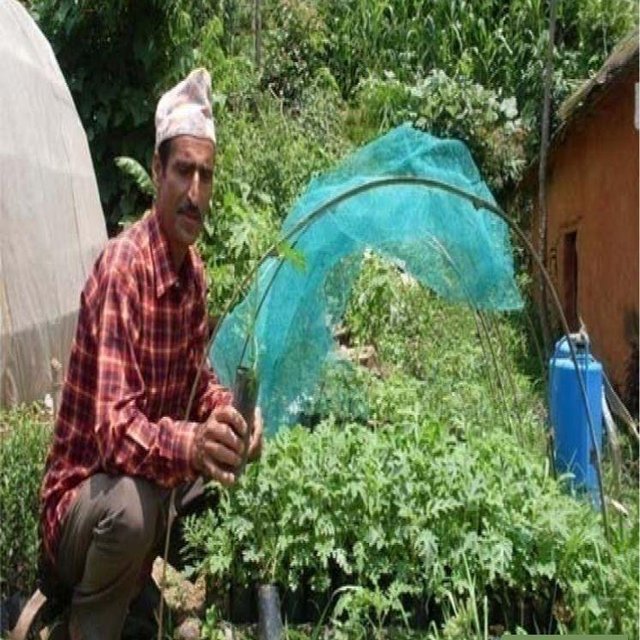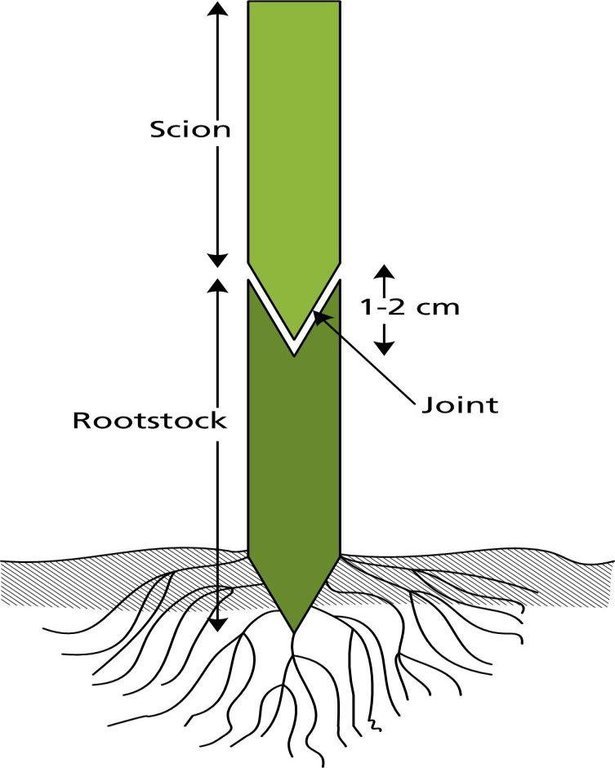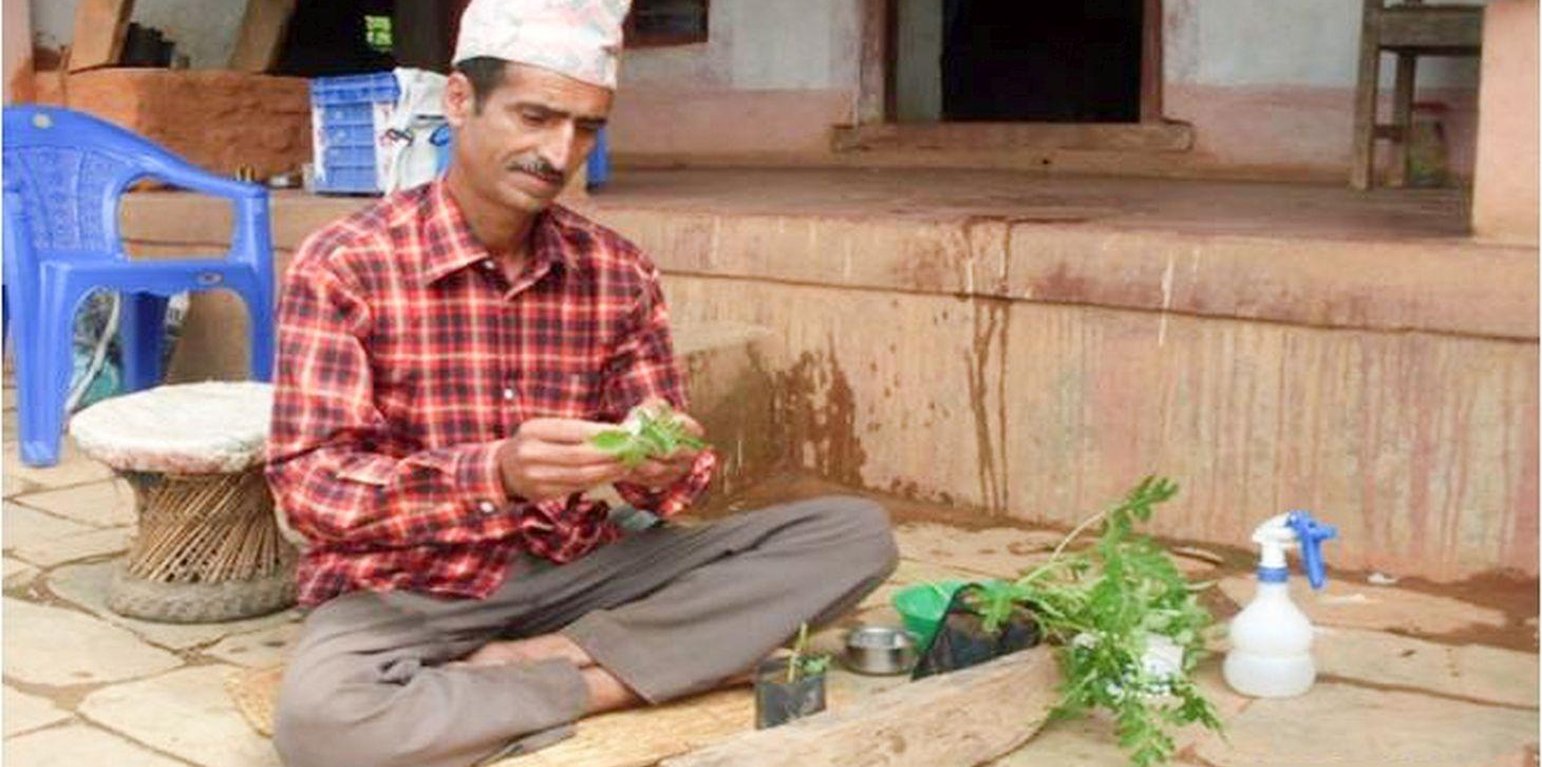Tomato Grafting
(Nepal)
Kalami Prabidhi Dwara Golbheda Uthapadan (Main Contributor: Purusottam Gupta, IDE Nepal)
Description
Cleft grafting can be used to produce plants that are resistant to a number of pests and diseases and are often higher yielding than the original. Tomato seedlings can be easily grafted onto resistant root stock of the wild eggplant (Solanum sysimbrifolium) to produce a disease-resistant and commercially viable crop.
Some of Nepal's most lucrative vegetable cash crops, especially solanaceous crops such as tomato and eggplant, are particularly susceptible to attack by the root knot nematode, Meliodogyne spp, which costs Nepal's farmers millions of rupees in losses annually. In recent years, farmers found that this pest was becoming prevalent and that they could not control it permanently using either cheap or eco-friendly solutions. Researchers and development officers took up the challenge and found that grafting technology could successfully control not only the root knot nematode but also wilting disease. As a bonus, they also found that grafting can increase the yield potential of the plants and improve the overall productivity of the land.
Establishment / maintenance activities and inputs: Loam and silt loam soils with a pH of 6.0–7.0 are the most suitable for this type of cultivation. Grafting technology requires two plants: the scion and the rootstock. The scion is a detached shoot or twig containing buds from the desired woody plant. The rootstock is a plant with an established healthy root system, onto which a cutting or a bud from another plant is grafted. The scion seedlings are grown in raised solarized nursery beds, where care has been taken to see that the soil has been sterilised and all soil pests have been destroyed. Robust rootstock of wild eggplant (Solanum sysimbrifolium) is appropriate for tomato propagation. The rootstock seedlings are grown in multi cell trays and transplanted when they are 20–25 cm high and have a few leaves and a pencil thick stalk. Seeds for the rootstock seedlings are sown in March/April and are ready in 6–8 weeks; scion seeds are sown in April/May and are ready for grafting in 3–4 weeks. Both scion and rootstock plants should have achieved similar stalk thicknesses at the time of grafting. Cleft grafting is carried out and the grafted seedlings kept in polypots in a closed polyhouse for 7–10 days. Then the grafted seedlings are carefully transplanted to their permanent location. The grafted plants are watered the day after they are transplanted; the extent of watering depends on how moist the soil is and on local weather conditions. The field is mulched throughout the cropping period using straw and other farm biomass materials.
Location
![]()
Location: Arukharka -6, Syangja District, Nepal
No. of Technology sites analysed:
Geo-reference of selected sites
Spread of the Technology: evenly spread over an area (approx. < 0.1 km2 (10 ha))
In a permanently protected area?:
Date of implementation:
Type of introduction
-
through land users' innovation
-
as part of a traditional system (> 50 years)
-
during experiments/ research
-
through projects/ external interventions

A farmer in Syngia showing tomato seedlings that have been grafted onto improved root stocks. (Purusottam Gupta)
Classification of the Technology
Main purpose
-
improve production
-
reduce, prevent, restore land degradation
-
conserve ecosystem
-
protect a watershed/ downstream areas – in combination with other Technologies
-
preserve/ improve biodiversity
-
reduce risk of disasters
-
adapt to climate change/ extremes and its impacts
-
mitigate climate change and its impacts
-
create beneficial economic impact
-
create beneficial social impact
Land use
Water supply
-
rainfed
-
mixed rainfed-irrigated
-
full irrigation
Purpose related to land degradation
-
prevent land degradation
-
reduce land degradation
-
restore/ rehabilitate severely degraded land
-
adapt to land degradation
-
not applicable
Degradation addressed
-
chemical soil deterioration - Cn: fertility decline and reduced organic matter content (not caused by erosion)
-
biological degradation - Bp: increase of pests/ diseases, loss of predators
-
water degradation - Hs: change in quantity of surface water
SLM group
-
integrated pest and disease management (incl. organic agriculture)
-
improved plant varieties/ animal breeds
SLM measures
-
agronomic measures - A5: Seed management, improved varieties
Technical drawing
Technical specifications
Schematic diagram of a tomato scion grafted on to the rootstock of a wild eggplant.
Technical knowledge required for field staff / advisors: high
Main technical functions: Reduce Pest Attack, Improve crop production

Author: A. K. Thaku
Establishment and maintenance: activities, inputs and costs
Calculation of inputs and costs
- Costs are calculated:
- Currency used for cost calculation: NPR
- Exchange rate (to USD): 1 USD = 72.0 NPR
- Average wage cost of hired labour per day: n.a
Most important factors affecting the costs
All costs and amounts are rough estimates by the technicians and authors.
Establishment activities
-
Prepare the land (Timing/ frequency: None)
-
Prepare Scions (Timing/ frequency: None)
-
Prepare rootstock (Timing/ frequency: None)
-
Grafting (Timing/ frequency: None)
-
Transplant grafted Seedling (Timing/ frequency: None)
Establishment inputs and costs
| Specify input |
Unit |
Quantity |
Costs per Unit (NPR) |
Total costs per input (NPR) |
% of costs borne by land users |
|
Labour
|
| Prepare the land |
persons/day |
5.0 |
4.2 |
21.0 |
100.0 |
|
Equipment
|
| Tools |
unit |
1.0 |
22.0 |
22.0 |
100.0 |
|
Plant material
|
| Seeds |
unit |
1.0 |
28.0 |
28.0 |
100.0 |
|
Fertilizers and biocides
|
| Fertilizer |
unit |
1.0 |
17.0 |
17.0 |
100.0 |
| Compost/manure |
unit |
1.0 |
65.0 |
65.0 |
100.0 |
| Pesticide |
unit |
1.0 |
21.0 |
21.0 |
100.0 |
| Plant tonic |
unit |
1.0 |
7.0 |
7.0 |
100.0 |
|
Construction material
|
| Polypot,grafting chamber etc |
unit |
1.0 |
225.0 |
225.0 |
100.0 |
| Total costs for establishment of the Technology |
406.0 |
|
| Total costs for establishment of the Technology in USD |
5.64 |
|
Maintenance activities
-
Both scion and rootstock seeds are watered after sowing. The seedlings are monitored and watered as needed. (Overall labor: 16 person days) (Timing/ frequency: None)
-
After transplanting, the grafted seedlings are watered the next day and twice weekly thereafter. As the plantlets mature, they are watered at 10-day intervals and the surface of the soil is mulched. The moisture level in the soil is monitored throughout the cropping period. (Timing/ frequency: None)
-
Top dressing with biofertilizers (N, P, K, and vesicular arbuscular mycorrhiza VAM) and bio-hume is applied to the root zone. (Timing/ frequency: None)
Maintenance inputs and costs
| Specify input |
Unit |
Quantity |
Costs per Unit (NPR) |
Total costs per input (NPR) |
% of costs borne by land users |
|
Labour
|
| Watering scion and rootstock |
persons/day |
16.0 |
4.25 |
68.0 |
100.0 |
|
Equipment
|
| Electricity and water charger |
unit |
1.0 |
8.5 |
8.5 |
100.0 |
|
Plant material
|
| Seeds |
unit |
1.0 |
68.0 |
68.0 |
100.0 |
| Total costs for maintenance of the Technology |
144.5 |
|
| Total costs for maintenance of the Technology in USD |
2.01 |
|
Natural environment
Average annual rainfall
-
< 250 mm
-
251-500 mm
-
501-750 mm
-
751-1,000 mm
-
1,001-1,500 mm
-
1,501-2,000 mm
-
2,001-3,000 mm
-
3,001-4,000 mm
-
> 4,000 mm
Agro-climatic zone
-
humid
-
sub-humid
-
semi-arid
-
arid
Specifications on climate
Thermal climate class: subtropics
Slope
-
flat (0-2%)
-
gentle (3-5%)
-
moderate (6-10%)
-
rolling (11-15%)
-
hilly (16-30%)
-
steep (31-60%)
-
very steep (>60%)
Landforms
-
plateau/plains
-
ridges
-
mountain slopes
-
hill slopes
-
footslopes
-
valley floors
Altitude
-
0-100 m a.s.l.
-
101-500 m a.s.l.
-
501-1,000 m a.s.l.
-
1,001-1,500 m a.s.l.
-
1,501-2,000 m a.s.l.
-
2,001-2,500 m a.s.l.
-
2,501-3,000 m a.s.l.
-
3,001-4,000 m a.s.l.
-
> 4,000 m a.s.l.
Technology is applied in
-
convex situations
-
concave situations
-
not relevant
Soil depth
-
very shallow (0-20 cm)
-
shallow (21-50 cm)
-
moderately deep (51-80 cm)
-
deep (81-120 cm)
-
very deep (> 120 cm)
Soil texture (topsoil)
-
coarse/ light (sandy)
-
medium (loamy, silty)
-
fine/ heavy (clay)
Soil texture (> 20 cm below surface)
-
coarse/ light (sandy)
-
medium (loamy, silty)
-
fine/ heavy (clay)
Topsoil organic matter content
-
high (>3%)
-
medium (1-3%)
-
low (<1%)
Groundwater table
-
on surface
-
< 5 m
-
5-50 m
-
> 50 m
Availability of surface water
-
excess
-
good
-
medium
-
poor/ none
Water quality (untreated)
-
good drinking water
-
poor drinking water (treatment required)
-
for agricultural use only (irrigation)
-
unusable
Water quality refers to:
Is salinity a problem?
Occurrence of flooding
Characteristics of land users applying the Technology
Market orientation
-
subsistence (self-supply)
-
mixed (subsistence/ commercial)
-
commercial/ market
Off-farm income
-
less than 10% of all income
-
10-50% of all income
-
> 50% of all income
Relative level of wealth
-
very poor
-
poor
-
average
-
rich
-
very rich
Level of mechanization
-
manual work
-
animal traction
-
mechanized/ motorized
Sedentary or nomadic
-
Sedentary
-
Semi-nomadic
-
Nomadic
Individuals or groups
-
individual/ household
-
groups/ community
-
cooperative
-
employee (company, government)
Age
-
children
-
youth
-
middle-aged
-
elderly
Area used per household
-
< 0.5 ha
-
0.5-1 ha
-
1-2 ha
-
2-5 ha
-
5-15 ha
-
15-50 ha
-
50-100 ha
-
100-500 ha
-
500-1,000 ha
-
1,000-10,000 ha
-
> 10,000 ha
Scale
-
small-scale
-
medium-scale
-
large-scale
Land ownership
-
state
-
company
-
communal/ village
-
group
-
individual, not titled
-
individual, titled
Land use rights
-
open access (unorganized)
-
communal (organized)
-
leased
-
individual
Water use rights
-
open access (unorganized)
-
communal (organized)
-
leased
-
individual
Access to services and infrastructure
Impacts
Socio-cultural impacts
food security/ self-sufficiency
Ecological impacts
resistance towards pests and disease
maintaining moisture in soil
Cost-benefit analysis
Benefits compared with establishment costs
Short-term returns
very negative
very positive
Long-term returns
very negative
very positive
Benefits compared with maintenance costs
Short-term returns
very negative
very positive
Long-term returns
very negative
very positive
Climate change
Gradual climate change
annual temperature increase
not well at all
very well
Climate-related extremes (disasters)
not well at all
very well
Other climate-related consequences
not well at all
very well
Adoption and adaptation
Percentage of land users in the area who have adopted the Technology
-
single cases/ experimental
-
1-10%
-
11-50%
-
> 50%
Of all those who have adopted the Technology, how many have done so without receiving material incentives?
-
0-10%
-
11-50%
-
51-90%
-
91-100%
Has the Technology been modified recently to adapt to changing conditions?
To which changing conditions?
-
climatic change/ extremes
-
changing markets
-
labour availability (e.g. due to migration)
Conclusions and lessons learnt
Strengths: land user's view
Strengths: compiler’s or other key resource person’s view
-
The technology is highly effective at controlling pests and disease.
How can they be sustained / enhanced? The wild eggplant rootstocks are somewhat difficult to graft because they are spiny. Spine-free rootstock seedlings would be easier to graft.
-
The grafted seedlings themselves are a good source of income for farmers.
How can they be sustained / enhanced? Create awareness among farmers and encourage nurseries to provide grafted seedlings. Support farmers during the start-up stage.
Weaknesses/ disadvantages/ risks: land user's viewhow to overcome
Weaknesses/ disadvantages/ risks: compiler’s or other key resource person’s viewhow to overcome
-
Grafting is time consuming and difficult because wild eggplant rootstock plants are spiny.
Need more research to identify other possible rootstock plants.
-
Grafting can be expensive and requires an initial investment in training; specialized materials are needed. Technically demanding, needs practise. Specialized materials are difficult to get.
Nurseries need to be supported and need to have access to specialized materials on time.
References
Reviewer
-
David Streiff
-
Alexandra Gavilano
Date of documentation: Aug. 14, 2015
Last update: Sept. 5, 2019
Resource persons
-
Shreedip Sigdel - SLM specialist
-
Purusottam Gupta - SLM specialist
-
KOMAL PRADHAN - SLM specialist
Full description in the WOCAT database
Documentation was faciliated by
Institution
- ICIMOD International Centre for Integrated Mountain Development (ICIMOD) - Nepal
- iDE Nepal (iDE Nepal) - Nepal
Project










